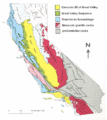Franciscan Assemblage facts for kids
The Franciscan Assemblage is a special group of rocks found mostly near San Francisco, California. Geologists use this term to describe these unique rocks. They tell an amazing story about how California was formed millions of years ago. These rocks are like clues from Earth's past.
Contents
What is the Franciscan Assemblage?
The Franciscan Assemblage is a collection of different rock types. These rocks formed deep under the ocean. They were later pushed up onto land. This happened over millions of years. The rocks are found along the coast of California. They stretch from Oregon down to Southern California.
How These Rocks Formed
These rocks formed because of a process called subduction. Subduction happens when one of Earth's huge tectonic plates slides beneath another. In this case, an ancient ocean plate slid under the North American plate. As the ocean plate went down, it scraped off layers of rock and sediment. These scraped-off materials piled up. They formed the Franciscan Assemblage. This process also created a lot of heat and pressure. This changed the rocks, making them unique.
A Mix of Ocean Rocks
The Franciscan Assemblage is like a giant mix of ocean floor materials. It includes rocks that were once deep-sea mud. It also has rocks that were once volcanic lava. These rocks were all brought together by the subduction process. They show us what the ocean floor looked like long ago.
Types of Rocks in the Assemblage
The Franciscan Assemblage contains several interesting rock types. Each type tells a different part of the story.
Mélange: A Rocky Mix-Up
One common type is called mélange. Imagine a giant rock smoothie! Mélange is a jumbled mix of different rock pieces. These pieces are floating in a softer, squished rock matrix. The matrix is often made of shale. The harder pieces can be sandstone or volcanic rocks. This mix-up happened because of the intense squeezing and grinding during subduction. You can see mélange at places like Marshall's Beach in San Francisco.
Ribbon Chert: Ancient Ocean Floors
Another cool rock is chert. This chert often looks like thin, colorful ribbons. It formed from the tiny skeletons of sea creatures called radiolarians. These creatures lived in the ancient ocean. When they died, their skeletons fell to the seafloor. Over time, they turned into hard chert layers. The ribbon-like look comes from different layers of sediment. You can find beautiful ribbon chert at the Marin Headlands.
Pillow Basalts: Underwater Lava
You might also find basalt rocks that look like pillows. These are called pillow basalts. They form when lava erupts underwater. As the hot lava hits the cold ocean water, it quickly cools. This creates rounded, pillow-shaped blobs. These rocks were once part of the ancient ocean floor. They were later scraped off and added to the Franciscan Assemblage.
Serpentinite: California's State Rock
Serpentinite is another important rock in this group. It's often green and feels smooth or waxy. It forms when rocks from Earth's deep mantle react with water. Serpentinite is special because it's California's official state rock! It can be found in many places, including Angel Island.
Blue Schist: High Pressure Rocks
Some rocks in the Franciscan Assemblage are called blue schist. These rocks get their blue color from a mineral called glaucophane. Blue schist forms under very high pressure but relatively low temperatures. This is exactly what happens during subduction. It's a key sign that these rocks were once deep underground.
Where to See the Franciscan Assemblage
You can see these amazing rocks in many places along the California coast. They are especially visible around the San Francisco Bay Area. Places like Marshall's Beach, the Marin Headlands, and Angel Island offer great views. These locations are like outdoor museums. They show how Earth's forces shaped our planet.
Images for kids
-
Ribbon Chert of the Marin Headlands Terrane, exposed at Marshall's Beach, San Francisco.
-
Folded blue metacherts with glaucophane-rich layers, exposed in outcrops on Kayak Beach, Angel Island, northern San Francisco Bay.
-
Sheared block-in-matrix fabric composed of serpentinite blocks in serpentinite matrix, exposed on Perles Beach, Angel Island, Marin County, California. Pencil for scale. The strong anastomosing foliation is folded, sub-vertical in the lower part of the photo and more gently dipping in the upper part of the photo.









